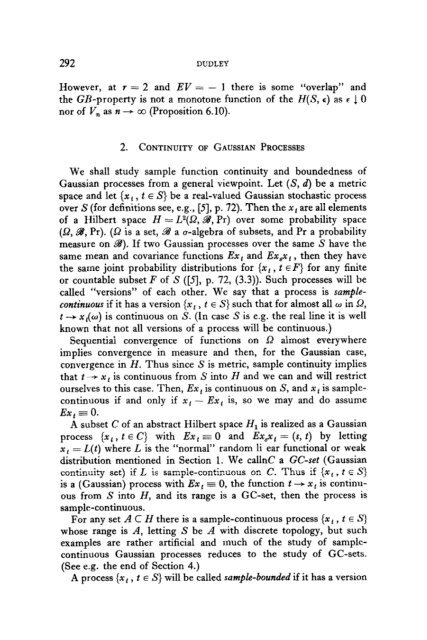On the Characters and the Plancherel Formula of Nilpotent Groups ...
On the Characters and the Plancherel Formula of Nilpotent Groups ...
On the Characters and the Plancherel Formula of Nilpotent Groups ...
Create successful ePaper yourself
Turn your PDF publications into a flip-book with our unique Google optimized e-Paper software.
292 DUDLEY<br />
However, at r = 2 <strong>and</strong> EV = - 1 <strong>the</strong>re is some “overlap” <strong>and</strong><br />
<strong>the</strong> GB-property is not a monotone function <strong>of</strong> <strong>the</strong> H(S, c) as E JO<br />
nor <strong>of</strong> V, as n -+ co (Proposition 6.10).<br />
2. CONTINUITY OF GAUSSIAN PROCESSES<br />
We shall study sample function continuity <strong>and</strong> boundedness <strong>of</strong><br />
Gaussian processes from a general viewpoint. Let (S, d) be a metric<br />
space <strong>and</strong> let (X t , t E S) be a real-valued Gaussian stochastic process<br />
over S (for definitions see, e.g., IS], p. 72). Then <strong>the</strong> xt are all elements<br />
<strong>of</strong> a Hilbert space H = La(D, 9, Pr) over some probability space<br />
(Q, a, Pr). (Q is a set, 99 a u-algebra <strong>of</strong> subsets, <strong>and</strong> Pr a probability<br />
measure on a). If two Gaussian processes over <strong>the</strong> same S have <strong>the</strong><br />
same mean <strong>and</strong> covariance functions Ex, <strong>and</strong> Ex,xt , <strong>the</strong>n <strong>the</strong>y have<br />
<strong>the</strong> same joint probability distributions for (xt , t EF} for any finite<br />
or countable subset F <strong>of</strong> S ([.5], p. 72, (3.3)). Such processes will be<br />
called “versions” <strong>of</strong> each o<strong>the</strong>r. We say that a process is samplecontinuous<br />
if it has a version (xt , t E S> such that for almost all w in J2,<br />
t -+ .X,(W) is continuous on S. (In case S is e.g. <strong>the</strong> real line it is well<br />
known that not all versions <strong>of</strong> a process will be continuous.)<br />
Sequential convergence <strong>of</strong> functions on 12 almost everywhere<br />
implies convergence in measure <strong>and</strong> <strong>the</strong>n, for <strong>the</strong> Gaussian case,<br />
convergence in H. Thus since S is metric, sample continuity implies<br />
that t + x1 is continuous from S into H <strong>and</strong> we can <strong>and</strong> will restrict<br />
ourselves to this case. Then, Ex, is continuous on S, <strong>and</strong> xt is samplecontinuous<br />
if <strong>and</strong> only if xt - Ex t is, so we may <strong>and</strong> do assume<br />
Ex, = 0.<br />
A subset C <strong>of</strong> an abstract Hilbert space Hi is realized as a Gaussian<br />
process {x f , t E C} with Ex t = 0 <strong>and</strong> Ex$x, = (s, t) by letting<br />
x1 = L(t) where L is <strong>the</strong> “normal” r<strong>and</strong>om li ear functional or weak<br />
distribution mentioned in Section 1. We callnC a G&et (Gaussian<br />
continuity set) if L is sample-continuous on C. Thus if (xt , t E S)<br />
is a (Gaussian) process with Ex, E 0, <strong>the</strong> function t -+ xb is continuous<br />
from S into H, <strong>and</strong> its range is a GC-set, <strong>the</strong>n <strong>the</strong> process is<br />
sample-continuous.<br />
For any set A C H <strong>the</strong>re is a sample-continuous process (xt , t E S}<br />
whose range is A, letting S be A with discrete topology, but such<br />
examples are ra<strong>the</strong>r artificial <strong>and</strong> much <strong>of</strong> <strong>the</strong> study <strong>of</strong> samplecontinuous<br />
Gaussian processes reduces to <strong>the</strong> study <strong>of</strong> GC-sets.<br />
(See e.g. <strong>the</strong> end <strong>of</strong> Section 4.)<br />
A process (x1 , t E S> will be called sample-bounded if it has a version

















